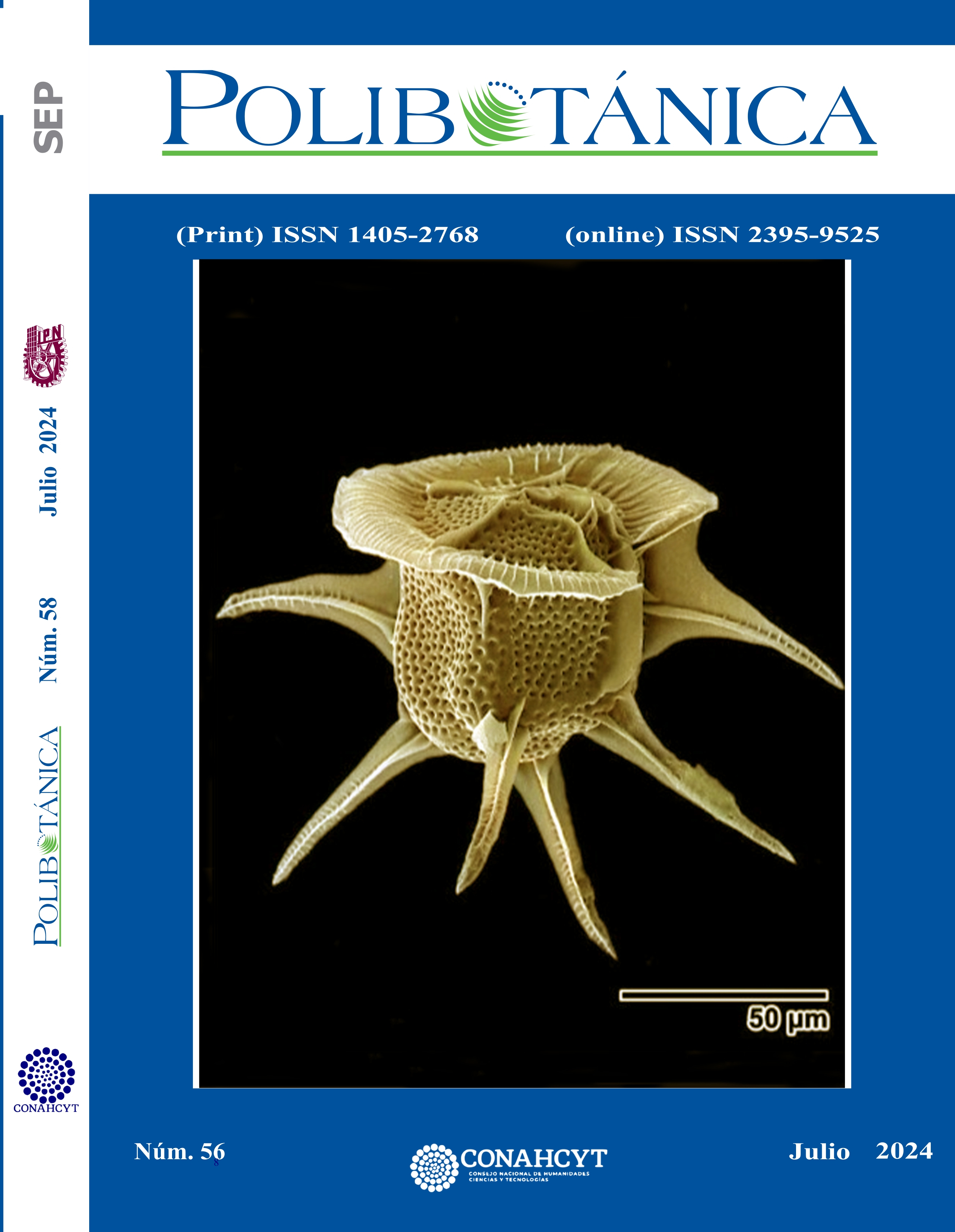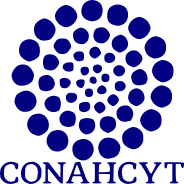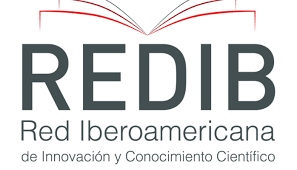Diversity of agaves used in the extraction of sap to produce aguamiel syrup in the state of Hidalgo, Mexico
DOI:
https://doi.org/10.18387/polibotanica.58.19Keywords:
agrobiodiversity of agaves, sap, sap syrup, morphometry, genetic diversityAbstract
Agaves are plants of biocultural importance for Mexicans, they have a long history of interaction with humans, in addition to being considered key plants of the environments where they grow. Currently, many of its ancient uses are still valid, reporting more than 100 different ones, which are grouped into 22 categories, where distilled beverages are economically important, with other uses that are gaining popularity, such as mead syrup. This study aims to describe the production systems where the agaves that are used for the extraction of sap or mead to produce mead syrup are kept, as well as to characterize the traditional varieties of agaves that are kept there. The study was carried out in five municipalities in the state of Hidalgo, considering a total of 12 locations. In each of the sampling sites, prospecting visits were carried out and eight productive systems were selected, in which the ethnobotanical evaluation was carried out with thematic tours, open and semi-structured interviews, the traditional varieties of agaves were morphologically characterized and genetic analyzes were carried out. with the use of 10 core microsatellites. The productive systems that were recorded were the metepantles, Ñu´tá, magueyeras and magueyes in living fences or boundaries that limit productive spaces. In these production systems it was observed that 28 traditional varieties of pulque agaves are maintained, which belong to four species of agaves. It was also found that the metepantle production systems in La Gaspareña (Singuilucan, Hidalgo) and the Ñu'ta del Cardonal production systems were the most agrobiodiverse. These regions in turn are differentiated by the preferred varieties for their work, the Manso being in the Altiplanicie Pulquera area and the Xaminí variety being the favorite in the Mezquital Valley. The genetic diversity ranged between 0.020 to 0.200, these values are in the range of those reported for other varieties in the state of Hidalgo and Mexico. The agrobiodiversity of the agaves used in this activity, together with the diversity found in the productive spaces and the knowledge of managers, make the production of aguamiel syrup in the state of Hidalgo an activity that maintains high biological and cultural diversity. However, we must warn about certain actions, such as the installation of various monocultures that can lead to negative consequences.
References
Álvarez Ríos, G. D. (2019). Influencia de la microbiota y el manejo sobre la calidad del pulque. Tesis de Maestría [Tesis de Maestría]. UNAM.
Álvarez-Duarte, M., García-Moya, E., Suárez-Espinosa, J., Luna-Cavazos, M., & Rodríguez-Acosta, M. (2018). Conocimiento tradicional, cultivo y aprovechamiento del maguey pulquero en los municipios de Puebla y Tlaxcala. Polibotánica, 45, 205–222.
Álvarez-Ríos, G. D., Figueredo-Urbina, C. J., & Casas, A. (2020). Sistemas de manejo de maguey pulquero en México. ETNOBIOLOGÍA, 18(2), 3–23. https://revistaetnobiologia.mx/index.php/etno/article/view/377
Álvarez-Ríos, G., Vallejo, M., Figueredo-Urbina, C. J., & Estremo, S. (2022). Agaves pulqueros de México. Mapa distribución y uso. UNAM.
Bernard Russell, H. (2017). Research methods in anthropology: qualitative and quantitative approaches.
Bremer, B., Bremer, K., Chase, M. W., Fay, M. F., Reveal, J. L., Bailey, L. H., Soltis, D. E., Soltis, P. S., Stevens, P. F., Anderberg, A. A., Moore, M. J., Olmstead, R. G., Rudall, P. J., Sytsma, K. J., Tank, D. C., Wurdack, K., Xiang, J. Q. Y., & Zmarzty, S. (2009). An update of the Angiosperm Phylogeny Group classification for the orders and families of flowering plants: APG III. Botanical Journal of the Linnean Society, 161(2), 105–121. https://doi.org/10.1111/J.1095-8339.2009.00996.X
Byers, C., Maughan, P. J., Clouse, J., & Stewart, J. R. (2014). Microsatellite Primers in Agave utahensis (Asparagaceae), a Keystone Species in the Mojave Desert and Colorado Plateau. https://doi.org/10.3732/apps.1400047, 2(9). https://doi.org/10.3732/APPS.1400047
Callen, E. (1967). Analysis of the Tehuacan coprolites. En Byers D (Ed.), The Prehistory of the Tehuacan Valley (First, Vol. 1, pp. 261–289). University of Texas Press.
Chase, M. W., Christenhusz, M. J. M., Fay, M. F., Byng, J. W., Judd, W. S., Soltis, D. E., Mabberley, D. J., Sennikov, A. N., Soltis, P. S., Stevens, P. F., Briggs, B., Brockington, S., Chautems, A., Clark, J. C., Conran, J., Haston, E., Möller, M., Moore, M., Olmstead, R., … Weber, A. (2016). An update of the Angiosperm Phylogeny Group classification for the orders and families of flowering plants: APG IV. Botanical Journal of the Linnean Society, 181(1), 1–20. https://doi.org/10.1111/BOJ.12385
Colunga-GarcíaMarín, P., Zizumbo-Villarreal, D., Torres, I., Casas, A., Figueredo-Urbina, C. J., Rangel-Landa, S., Delgado-Lemus, A., & Carrillo-Galván, G. (2017). Los agaves y las prácticas mesoamericanas de aprovechamiento, manejo y domesticación. En A. Casas, J. Torres, & F. Parra (Eds.), Domesticación en el Continente Americano (1a ed., Vol. 2). UNAM-UNALM.
Eguiarte, L. E., Aguirre-Planter, E., Aguirre, X., Colín, R., González, A., Rocha, M., Scheinvar, E., Trejo, L., & Souza, V. (2013). From Isozymes to Genomics: Population Genetics and Conservation of Agave in México. Botanical Review, 79(4), 483–506. https://doi.org/10.1007/S12229-013-9123-X/METRICS
Escalante, A., López Soto, D. R., Velázquez Gutiérrez, J. E., Giles-Gómez, M., Bolívar, F., & López-Munguía, A. (2016). Pulque, a Traditional Mexican Alcoholic Fermented Beverage: Historical, Microbiological, and Technical Aspects. Frontiers in Microbiology, 7(JUN), 1026. https://doi.org/10.3389/FMICB.2016.01026
Figueredo-Urbina, C. J., Álvarez-Ríos, G. D., García-Montes, M. A., & Octavio-Aguilar, P. (2021). Morphological and genetic diversity of traditional varieties of agave in Hidalgo State, Mexico. PLOS ONE, 16(7), e0254376. https://doi.org/10.1371/JOURNAL.PONE.0254376
García-Mendoza, A. J., Martínez, I. S. F., & Gutiérrez, D. S. (2019). Cuatro especies nuevas de Agave (Asparagaceae, Agavoideae) del sur de México. Acta Botánica Mexicana, 126(126), 1–18. https://doi.org/10.21829/ABM126.2019.1461
Gentry, H. Scott. (1982). Agaves of continental North America. University of Arizona Press. https://books.google.com/books/about/Agaves_of_Continental_North_America.html?hl=es&id=TdgUAQAAIAAJ
Goncalves de Lima, O. (1986). El maguey y el pulque en los códices mexicanos (Primera). FCE.
Granados, D. (119d. C.). Los agaves en México. Universidad Autónoma de Chapingo.
Hamrigk, J. L., & Godt, M. J. W. (1996). Effects of life history traits on genetic diversity in plant species. Philosophical Transactions of the Royal Society of London. Series B: Biological Sciences, 351(1345), 1291–1298. https://doi.org/10.1098/RSTB.1996.0112
Lindsay, D. L., Edwards, C. E., Jung, M. G., Bailey, P., & Lance, R. F. (2012). Novel microsatellite loci for Agave parryi and cross-amplification in Agave palmeri (Agavaceae). American Journal of Botany, 99(7), e295–e297. https://doi.org/10.3732/AJB.1200033
MacNeish, R. (1967). A summary of the subsistence. En D. Byers (Ed.), The Prehistory of the Tehuacan Valley. (Vol. 1, pp. 290–310). University of Texas Press.
Mora-López, L., Reyes-Agüero, A., Flores-Flores, L., Flores-Flores, B., & Aguirre-Rivera, R. (2019). Variación morfológica y humanización de la sección Salmianae del género Agave. https://www.scielo.org.mx/scielo.php?script=sci_arttext&pid=S1405-31952011000400006
Muñoz-Camacho, L. L., Bello-Cervantes, E., Romano-Grande, E., & Trejo, L. (2023). Diversidad y conocimiento tradicional de agaves pulqueros en la comunidad de San Pedro Tlalcuapan, Tlaxcala, México. Revista Mexicana de Biodiversidad, 94, e944979–e944979. https://doi.org/10.22201/IB.20078706E.2023.94.4979
Nybom, H., & Bartish, I. V. (2000). Effects of life history traits and sampling strategies on genetic diversity estimates obtained with RAPD markers in plants. Perspectives in Plant Ecology, Evolution and Systematics, 3(2), 93–114. https://doi.org/10.1078/1433-8319-00006
Palomino, G., Martínez, J., Cepeda-Cornejo, V., & Pimienta-Barrios, E. (2012). Nuclear genome size and cytotype analysis in Agave cupreata Trel. & Berger (Agavaceae). Caryologia, 65(4), 281–294. https://doi.org/10.1080/00087114.2012.752915
Palomino, G., Martínez, J., & Méndez, I. (2007). Variación inter e intraespecífica en especies de Agave por citometría de flujo y análisis de sus cromosomas. En P. Colunga-GarcíaMarín, A. Larqué, L. Eguiarte, & D. Zizumbo-Villareal (Eds.), En lo ancestral hay futuro: del tequila, los mezcales y otros agaves (1a ed.). CICY, CONACYT, CONABIO, INE y SEMARNAT.
Peakall, R., & Smouse, P. E. (2012). GenAlEx 6.5: genetic analysis in Excel. Population genetic software for teaching and research—an update. Bioinformatics, 28(19), 2537. https://doi.org/10.1093/BIOINFORMATICS/BTS460
Reyes-Agüero, J. A., Peña-Valdivia, C. B., Aguirre-Rivera, J. R., & Mora-López, J. L. (2019). Variación intraespecífica de Agave mapisaga Trel. y Agave salmiana Otto Ex Salm-Dyck. (Asparagaceae) relacionada con los usos ancestrales en la región Hñähñu en el centro de México. Agrociencia, 53(4), 563–579. https://agrociencia-colpos.org/index.php/agrociencia/article/view/1828
Robert, M. L., Lim, K. Y., Hanson, L., Sanchez-Teyer, F., Bennett, M. D., Leitch, A. R., & Leitch, I. J. (2008). Wild and agronomically important Agave species (Asparagaceae) show proportional increases in chromosome number, genome size, and genetic markers with increasing ploidy. Botanical Journal of the Linnean Society, 158(2), 215–222. https://doi.org/10.1111/J.1095-8339.2008.00831.X
Rojas, G. A., Porfirio, J., Solano, L., & Rodríguez Pérez, J. E. (2007). DIVERSIDAD GENÉTICA EN POBLACIONES DE AGAVES PULQUEROS (Agave spp.) DEL NORORIENTE DEL ESTADO DE MÉXICO. Revista Fitotecnia Mexicana, 30(1), 1–1. https://doi.org/10.35196/RFM.2007.1.1
Sahagún, B. (1999). Historia general de las cosas de la Nueva España (1a ed.). Purrúa.
Smith, E. (1967). Plant Remains. En The Prehistory of the Tehuacan Valley. Environment and Subsistence (pp. 220–255).
Thiede, J. (2020). Agave AGAVACEAE. Monocotyledons, 21–311. https://doi.org/10.1007/978-3-662-56486-8_111
Trejo, L., Reyes, M., Cortés-Toto, D., Romano-Grande, E., & Muñoz-Camacho, L. L. (2020). Morphological Diversity and Genetic Relationships in Pulque Production Agaves in Tlaxcala, Mexico, by Means of Unsupervised Learning and Gene Sequencing Analysis. Frontiers in Plant Science, 11, 524812. https://doi.org/10.3389/FPLS.2020.524812/BIBTEX
Trejo, L., Velázquez, M. D. L. L., Vallejo, M., & Montoya, A. (2022). Differentiating Knowledge of Agave Landraces, Uses, and Management in Nanacamilpa, Tlaxcala. https://doi.org/10.2993/0278-0771-42.1.31, 42(1), 31–50. https://doi.org/10.2993/0278-0771-42.1.31
Vela, E., Montúfar A, Anzures, N., Martínez, E., Jarquín, A., & Hernández, F. (2014). El Maguey. Arqueología Mexicana, 57, 1–90.
Downloads
Published
License

Polibotánica by Departamento de Botánica de la Escuela Nacional de Ciencias Biológicas del Instituto Politécnico Nacional se distribuye bajo una Licencia Creative Commons Atribución-NoComercial-CompartirIgual 4.0 Internacional.




















